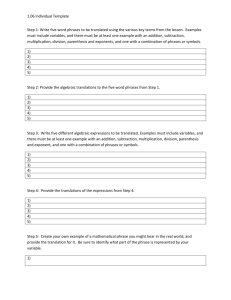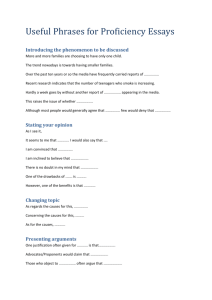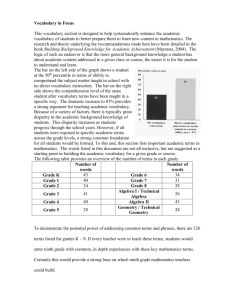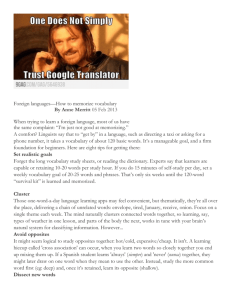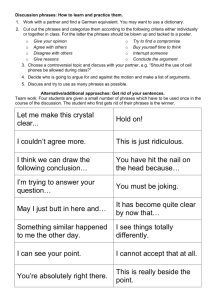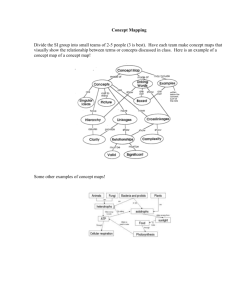Introduction
advertisement
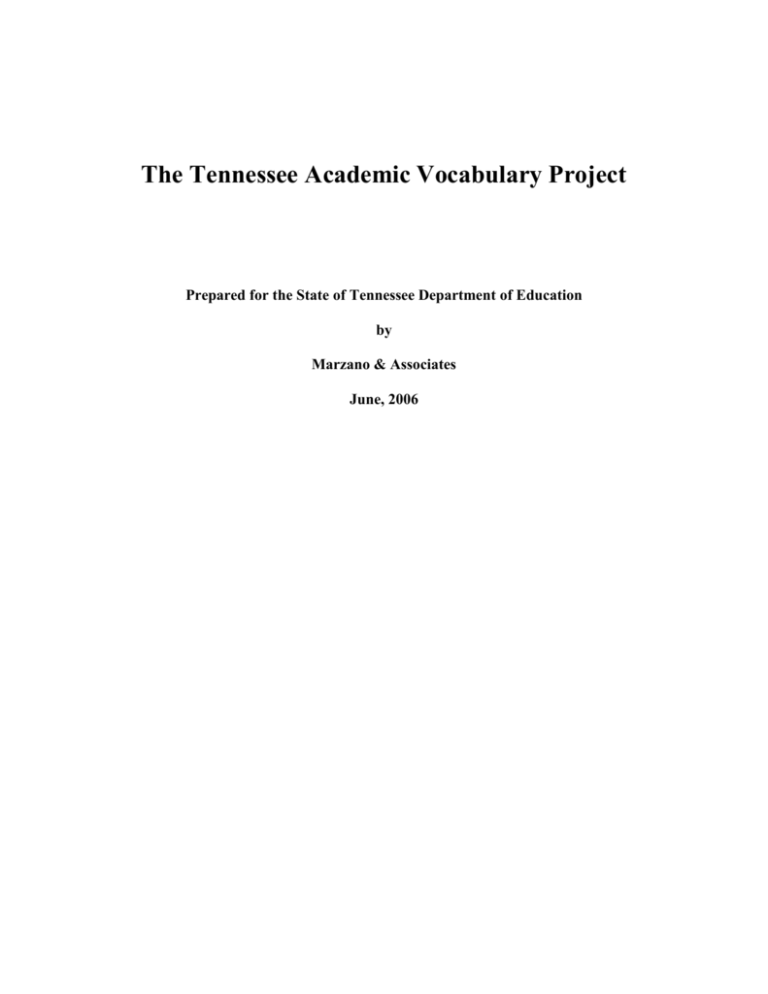
The Tennessee Academic Vocabulary Project Prepared for the State of Tennessee Department of Education by Marzano & Associates June, 2006 Table of Contents Overview . . . . . . . . . . . . . . . . . . . . . . . . . . . . . . . . . . . . . . . . . . . . . . . . . . . . . . . . . . . . . 2 How the Terms and Phrases Were Identified . . . . . . . . . . . . . . . . . . . . . . . . . . . . . . . . 5 How to Teach the Terms and Phrases . . . . . . . . . . . . . . . . . . . . . . . . . . . . . . . . . . . . . . 6 Final Comments . . . . . . . . . . . . . . . . . . . . . . . . . . . . . . . . . . . . . . . . . . . . . . . . . . . . . . . 10 Appendix A – Language Arts Word List . . . . . . . . . . . . . . . . . . . . . . . . . . . . . . . . . . . 11 Appendix B – Mathematics Word List . . . . . . . . . . . . . . . . . . . . . . . . . . . . . . . . . . . . .15 Appendix C -- Science Word List . . . . . . . . . . . . . . . . . . . . . . . . . . . . . . . . . . . . . . . . 21 Appendix D – Social Studies Word List . . . . . . . . . . . . . . . . . . . . . . . . . . . . . . . . . . . .26 References . . . . . . . . . . . . . . . . . . . . . . . . . . . . . . . . . . . . . . . . . . . . . . . . . . . . . . . . . . . .30 Pg. 1 Overview This manual is designed to help school districts or individual schools systematically enhance the academic vocabulary of their students to better prepare them to learn new content in mathematics, science, language arts, and social studies. The research and theory underlying the recommendations made here have been detailed in the book Building Background Knowledge for Academic Achievement (Marzano, 2004). Briefly, though, the logic of such an endeavor is that the more general background knowledge a student has about the academic content that will be addressed in a given class or course, the easier it is for the student to understand and learn the new content addressed in that class or course. Unfortunately because of a variety of factors, including differences in the extent to which experiences at home help enhance academic background knowledge, students transferring from one school to another or one district to another, and so on, there is typically great disparity in the academic background knowledge of students, and this disparity increases as students progress through the school years. However, if a district (or school) were to systematically ensure that all students were exposed to specific academic terms and phrases across the grade levels, this would form a strong common foundation for all students. To this end, this manual lists important academic terms and phrases in mathematics, science, language arts, and social studies. Table 1 provides an overview of the number of terms and phrases in each subject area: Pg. 2 Table 1 – Terms and Phrases by Grade/Course within Subject Area Grade K Grade 1 Grade 2 Grade 3 Grade 4 Grade 5 Grade 6 Grade 7 Grade 8 Language Arts 23 27 29 30 23 27 27 29 28 Social Studies 21 25 23 29 25 18 32 32 29 26 28 28 23 26 31 28 29 Biology Earth Science Physical Science Economics Geography Government U. S. History World History Science 23 27 26 26 27 24 27 29 29 26 19 Foundations I Foundations II Algebra I / Technical Algebra Algebra II Geometry / Technical Geometry Integrated Mathematics I Integrated Mathematics II Grade 9 Grade 10 Mathematics 29 28 26 26 23 27 33 25 26 30 26 35 39 31 44 34 Pg. 3 Table 1 illustrates that approximately 30 terms and phrases have been identified for each subject area for grades K – 8. In addition approximately 30 terms have also been identified for the following general courses: Language Arts Grade 9 Grade 10 Mathematics Foundations I Foundations II Algebra I / Technical Algebra Algebra II Geometry / Technical Geometry Integrated Mathematics I Integrated Mathematics II Science Biology Earth Science Physical Science Social Studies Economics Geography Government U. S. History World History Pg. 4 How the Terms and Phrases Were Identified It is important to note that the terms and phrases listed in this document are meant as “examples.” They are not to be considered implicitly or explicitly a list of “mandated” terms and phrases. Rather districts (or schools) might decide to add terms and phrases, delete terms and phrases, further define terms and phrases, or create their own lists which are completely different from those offered here. The lists provided here were generated by groups of volunteer subject matter and grade level specialists from Tennessee schools whose charge was to identify those terms and phrases that are important to student understanding of mathematics, science, language arts, and social studies. Approximately 30 terms were identified in each subject area so as not to overburden an individual classroom teacher. For example, a third grade teacher in a self-contained classroom whose job it is to teach all four of these subject areas would be responsible for about 120 terms and phrases. During a 36 week school year this would amount to about 14 terms and phrases per month allowing adequate time for the teacher to address many other terms of her own choosing. For example, the teacher could attend to the 120 pre-identified terms and phrases and still teach important words found in a story or important words found in a chapter of a textbook. In fact, research indicates that about 400 terms and phrases per year are typically addressed in programs that emphasize vocabulary instruction (see Marzano, 2004, p. 63). Identifying 120 terms and phrases leaves about 280 terms and phrases that are specific to an individual teacher. Pg. 5 To demonstrate the potential power of teachers within a district addressing common terms and phrases, consider the subject of mathematics. In mathematics 244 terms and phrases are listed for grades K – 8. If every teacher in a district were to teach these terms and phrases, students in that district would enter ninth grade with common, in depth experiences in these 244 key mathematics terms and phrases. Certainly this would provide a strong base on which ninth grade mathematics teachers could build. How to Teach the Terms and Phrases There is no single best way to teach terms and phrases. However, the research and theory on vocabulary development does point to a few generalizations that provide strong guidance. Initially Provide Students with a Description, Explanation, or Example as Opposed to a Formal Definition When introducing a new term or phrase it is useful to avoid a formal definition—at least at the start. This is because formal definitions are typically not very “learner friendly.” They make sense after we have a general understanding of a term or phrase, but not in the initial stages of learning. Instead of beginning with a definition, it is advisable to provide students with a description, explanation, or example much like what one would provide a friend who asked what a term or phrase meant. Pg. 6 Have Students Generate Their Own Descriptions, Explanations, or Examples Once a description, explanation, or example has been provided to students they should be asked to restate that information in their own words. It is important that students do not copy exactly what the teacher has offered. Student descriptions, explanations, and examples should be their own constructions using their own background knowledge and experiences to forge linkages between the new term or phrase and what they already know. Have Students Represent Each Term or Phrase Using a Graphic Representation, Picture, or Pictograph Once students have generated their own description, explanation, or example they should be asked to represent the term or phrase in some graphic, picture, or pictographic form. This allows them to process the information in a different modality—an imagery form as opposed to a linguistic form. It also provides a second processing of the information which should help deepen students’ understanding of the new term or phrase. Pg. 7 Have Students Keep an Academic Vocabulary Notebook One of the basic assumptions underlying the approach outlined in this manual is that over time students will develop an understanding of a set of terms and phrases that are important to the academic content in mathematics, science, language arts, and social studies. This implies that the terms and phrases that are taught using this approach represent a related set of knowledge that expands and deepens from year to year. To facilitate this cumulative effect it is highly advisable for students to keep an “academic vocabulary” notebook that contains the terms and phrases that have been taught. Enough space should be provided for students to record their initial descriptions, explanations, and examples of the terms and phrases as well as their graphic representations, pictures, and pictographs. Space should also be provided for students to write additional comments about the terms and phrases as time goes on. As mentioned in the next section, students should be engaged in activities that allow them to review the terms and phrases in their academic vocabulary notebooks and add to their knowledge base regarding specific terms and phrases. As these activities occur, students can be asked to add to the entries in their notebooks perhaps correcting misconceptions, adding new information, or making linkages with other terms and phrases. Pg. 8 Ideally, all terms and phrases are kept in one academic notebook that has a “tab” or divider for each subject area. This would allow students to make comparisons between terms and phrases from different subject areas. The academic notebook might also have a tab or divider entitled “my words.” In this section students would record terms and phrases of interest gleaned from their own reading experiences in or outside of school. Periodically Review the Terms and Phrases and Provide Students with Activities That Add to Their Knowledge Base If students experience a new term or phrase once only, they will be left with their initial, partial understanding of the term or phrase. To develop deep understanding of the terms and phrases in their academic vocabulary notebooks students must be engaged in review activities. Once a week or perhaps more frequently, students might be offered activities that add to their knowledge base about the terms and phrases in their notebooks. For example, they might make comparison between selected terms in a given subject area or between subject areas; they might create analogies or metaphors for selected terms; they might simply compare their entries with those of other students. Finally, they might be engaged in games that use the terms and phrases from their academic vocabulary notebooks. After each of these activities students should be asked to make corrections, additions, and changes to the entries in their notebooks. In this way, students’ knowledge of the academic terms and phrases might deepen and become a sound foundation on which to understand the academic content presented in class. Pg. 9 Final Comments The terms and phrases listed in this manual are offered to Tennessee districts and schools as a foundation from which to design and implement a comprehensive program to enhance the academic background knowledge of students. Districts and schools are encouraged to use this resource in ways that best suit their needs and dispositions. Pg. 10 Appendix A – Language Arts | Word List Kindergarten First Grade Second Grade alphabet back cover / front cover date drawing fairy tale first name / last name follow / give directions letter letter - sound relationship listening skill number word picture book picture dictionary poem print retell rhyme sight word sign speech Title/title page (introduction) word word families author / illustrator blends capitalization chapter character complete comprehension consonants/consonant blends create describe direction fantasy final illustrate initial language magazine order predict punctuation (basic) questions reality syllable symbol uppercase/lowercase vocabulary vowel (long/short) adjective composition conversation dictionary discussion everyday language fiction folktale glossary group discussion guest speaker main character main idea margin mental image message nonfiction noun predictable book prewriting pronoun publish purpose reread spelling pattern table of contents textbooks theater verb (action word) *These terms are words included in the state frameworks that have been deemed essential knowledge for end of course tests. Pg. 11 Appendix A – Language Arts | Word List Third Grade Fourth Grade Fifth Grade abbreviation adverb antonyms apostrophe chronological order complete sentence context clues contraction declarative exclamatory fact interrogative multi-meaning words opinion organization plural possessive predicate prefixes punctuation (commas) root word run-on sentence (introduction) singular story elements (character, setting, plot) subject suffixes summarize supporting details synonyms verb (types and functions) analogy audience (as listeners and readers) author's purpose cause/effect compare/contrast double negatives drawing conclusions encyclopedia fable genre (introduction) index making inferences myth outline possessive nouns proofread punctuation (quotation marks) sentence fragment simple predicate simple subject thesaurus title page (parts of) verb tense alliteration caption (identify) comparative coordinating conjunctions hyperbole idiom (introduction) interjections introductory paragraph main idea/stated and implied metaphor narrative onomatopoeia parts of speech personification plot point of view/perspective prompt punctuation marks (colon, semi-colon) reference source root words (as aids in determining meaning) run-on sentence (correcting) simile summary superlative text theme transitional words *These terms are words included in the state frameworks that have been deemed essential knowledge for end of course tests. Pg. 12 Appendix A – Language Arts | Word List Sixth Grade Seventh Grade Eighth Grade affix almanac analogy (part to whole/function) appositive caption (determine function) chronology clause (dependent/independent) common feature criticism dialect (introduction) edit literal vs. figurative log mythology oral tradition paraphrase phrases (adj., adv., prep., inf., etc.) plagiarism poetic element (e.g., rhyme, rhythm, and figurative language) point of view (1st, 3rd limited, and 3rd omniscient) propaganda devices proverb relevant/irrelevant rephrasing stress tabloid textual features analogy (verb forms, rhymes) anecdote assumption /assume clarify clause (adverb, introductory, etc) compile contract convention culture documentary exposition (literary) expository writing expression (emphasis, stress, etc. in oral language) fluency generalization imagery inconsistency infinitive interpretation literary elements (irony, mood, foreshadowing, flashback, tone, symbolism) parallel structure projection prose revision sentence structure stereotype strategy types of poetry viewpoint allusion (define concept with simple illustrations) antecedent* (pronoun/antecedent agreement) bias clincher sentence coherent order composition structure (structural patterns in composition) cross-reference debate derivation dramatization elaboration (supportive details) facilitator (role identification/groups) gerund and gerund phrase infer from unstated assumptions jargon logic (inductive/deductive reasoning) mnemonic device oral language techniques (inflection, enunciation, rate, and pitch) participial phrase and participles persuasive writing techniques preface reliability sensory detail shades of meaning synthesize/analyze tension thesis statement writing process *These terms are words included in the state frameworks that have been deemed essential knowledge for end of course tests. Pg. 13 Appendix A – Language Arts | Word List Ninth Grade Tenth Grade active listening skills allusion (classical, Biblical, historical, mythological) antecedent* character motivation* citation* coherence* comma splice (comma fault) couplet descriptive* writing (vivid details) dialect (uses of dialect) diction* dramatic monologue* elements of plot (rising action, conflict, climax, falling action)* epic excerpt* figurative language (simile, metaphor, personification, alliteration, onomatopoeia)* genre intervening* word phrases or clauses in writing irony* (situational, verbal, and dramatic) narration* non-verbal feedback* non-verbal language (gestures, body language) omniscient* recurring themes revise* Shakespearean English shift* (tense/point of view) soliloquy target audience* types of conflict (man vs. man, man vs. environment, man vs. himself, man vs. supernatural, external, internal)* allegory ambiguity assonance censorship conjunctive adverbs credible sources cultural perspective etymology idiom (figurative language) incongruity juxtaposition literary analysis logical fallacy MLA, APA (documentation styles) parallelism* paraphrasing* persona précis primary source/secondary source rebuttal* semantics sentence variety stream of consciousness syntax understatement (litotes) vernacular *These terms are words included in the state frameworks that have been deemed essential knowledge for end of course tests. Pg. 14 Appendix B – Math | Word List Kindergarten First Grade Second Grade above behind below calendar circle clock day graph (introduction) hour in front inside left money months number number line outside pattern rectangle right shape size sorting square triangle under week year zero addition backward/ forward between chart coin corner digit direction doubles even/odd greater than grouping guess half hour inch less than lists measure minus minute numeral plus pound solve subtraction sum temperature total cardinal number chance decreasing pattern difference distance foot (measurement) fraction geometric shapes/figures height increasing pattern length model numeric pattern ordinal number outcome pattern extension quarter-hour regroup second (time) set standard measurement symmetry table time interval whole number width Pg. 15 Appendix B – Math | Word List Third Grade Fourth Grade Fifth Grade addend area array commutative property data decimal denominator elapsed time estimation factor graph (using different types) horizontal measurement metric system multiple letter/number coordinates number sentence numerator perimeter place value probability (conceptual) product scale three-dimensional two-dimensional vertical acute associative property attributions capacity computation congruent dividend divisor equivalent grid hundredths identity property mass median mode obtuse quotient reasonable similar (comparing figures) tenths transformations (flips, slides, turns) volume (conceptual) zero property diameter distributive property (numeric) edges equation (modeling) expanded form faces improper fraction intersecting (lines) inverse operation mean metric units (meter, liter, gram) millions mixed numbers parallel (lines) perpendicular (lines) plane polygon (regular/irregular) proper fraction quadrilateral radius ray standard form thousandths types of triangles (isosceles, equilateral, scalene, right, acute, obtuse) variable vertex or vertices x, y axis Pg. 16 Appendix B – Math | Word List Sixth Grade Seventh Grade Eighth Grade algebraic expression (conceptual modeling) bias composite conjecture (with data) coordinate plane (ordered pairs) degrees (angle) equation (solving) evaluate formula function inverse measures of central tendency odds (probability) order of operations percent prime probability properties of shapes and figures proportion random rate of change ratio reciprocal sample scale drawing simplify simulation statistics stem-and-leaf plot tessellation transformation tree diagram volume acute triangle area of complex shapes area of irregular shapes box & whisker plot equiangular triangle equilateral triangle exponential notation exponents inequalities (number line) integer isosceles triangle linear equation multi-step equations obtuse triangle opposite percents (above 100, below 1) pi (approximation, i.e. 3.14, 22/7) rational numbers regular polygon right triangle scale factor scalene triangle scatter plots similarity surface area adjacent (angle relationship) alternate exterior angle alternate interior angle complementary corresponding cost per unit dilation distance formula (d=rt) distributive property (algebraic) experimental probability exterior infinite intercept interior line of best fit (conceptual) nonlinear equation perfect square Pythagorean theorem scientific notation sequences slope intercept form square root supplementary theoretical probability vertical angles vertical line test Pg. 17 Appendix B – Math | Word List Foundations I Foundations II accuracy area composite coordinate system cost per unit greatest common factor intercept least common multiple monomial opposite ordered pair percent perfect square perimeter precision prime factorization proportion quadrilateral ratio reciprocal scale drawing slope stem-and-leaf plot surface area tree diagram volume algebraic expression coefficients composite numbers constants coordinate (number line) degree (polynomial) exponential form factored form hypotenuse inequalities integer like terms linear equation linear graph Pythagorean theorem rational number right triangle similar triangles verbal expression Algebra I / Technical Algebra absolute value algebraic expressions coefficients combinations constants coordinate plane distance formula domain & range equations (solving, graphing, slope-intercept, etc.) factoring function notation inequalities inverse operations (algebraic) irrational numbers line of best fit linear systems (elimination, substitution) midpoint formula permutations polynomial Pythagorean theorem (area model) quadratic equation quadratic formula (discriminant) ratio/proportion (scale factors) real slope subsets Pg. 18 Appendix B – Math | Word List Algebra II Cartesian plane completing the square complex numbers conic sections conjugate (complex) correlation Cramer's rule delta ∆ dependent/ independent events factorial functions (exponential, polynomial, logarithmic, etc.) inverse function logarithm matrices mutually exclusive normal distribution curve parent function Pascal's triangle probability (theoretical, experimental) radical equation range (function) rational expression sampling scalar (multiplication) sigma ∑ synthetic division three-dimensional coordinate transformation (algebraic) Geometry / Technical Geometry adjacent altitude angle of depression angle of elevation bisect central angle chord complementary (expressed algebraically) congruence conjecture corresponding parts deductive reasoning geometric mean inductive reasoning inscribed median of a triangle parallel perpendicular pi proof (formal, paragraph, flow, coordinate) reflexive, symmetric, and transitive properties secant line similarity supplementary (expressed algebraically) surface area (lateral/ total) tangent line theorem transversal Integrated Mathematics I bar graphs central tendency circle graphs distance formula domain & range expression Fibonacci sequence function (exponential, polynomial) inequalities inverse operations (algebraic) irregular geometric figures line of best fit measure of dispersion non linear graph Pascal's triangle permutations pi Pythagorean theorem (area model) quadratic equation real numbers relationship slope solve system of equations Pg. 19 Appendix B – Math | Word List Integrated Mathematics II absolute value bisect Cartesian plane chord complex numbers congruence deductive reasoning geometric mean inductive reasoning inscribed irrational mutually exclusive networks parallel perpendicular polynomial probability ratio/ proportion (scale factors) rationalize secant line similarity supplementary (expressed algebraically) surface area (lateral/ total) system of linear equations tangent line validity Pg. 20 Appendix C – Science | Word List Kindergarten First Grade Second Grade air animal features cloud color day egg food growth insect month night parent plant ruler seasonal change senses shape size soil water weather week year balance dinosaur earth gravity environment freezing heat light location machine magnet mammoth moon ocean position prediction properties of light pulling pushing salt water sand shelter sky star sun's position sun's size thermometer weather patterns (seasons) behavior pattern characteristics circular motion/ straight line motion / zigzag movement dissolving distance diversity of life earth resources gas habitat individual differences liquid magnification magnifier observation parent/offspring similarity pebble prehistoric properties reasoning scientist similarities & differences solid sound universe vibration weight Pg. 21 Appendix C – Science | Word List Third Grade Fourth Grade Fifth Grade atmosphere conservation energy extinct force geological features life cycle magnetic attraction matter moon phases (basic four) natural resources observe offspring orbit organism photosynthesis physical change physical properties pollution predator prey rotation scientific method solar system water cycle weathering adaptations amphibians cell (wall, membrane, cytoplasm, nucleus) condensation earth's layers (crust, mantle, core) edible (parts of plants) endangered erosion evaporation friction gravity heredity lunar mammals mixture/solution moon phases (correct sequence) parallel circuit pitch precipitation renewable / non-renewable reptiles series circuit simple machines solar energy threatened thriving traits / characteristics acids /bases chemical change chemical properties concave lens conduction conductor contract/expand convection convex lens ecosystem environmental changes (human & nature) fossils (relative age) inherited traits insulator kinetic energy light reflection magnetic field mass metamorphosis (complete & incomplete) potential energy radiation revolution species states of matter Pg. 22 Appendix C – Science | Word List Sixth Grade Seventh Grade Eighth Grade absorption amplitude classification commensalism consumer decomposer eclipses (solar/ lunar) energy transformations extinction food web forms of energy fossils frequency heat flow mutualism nuclear power parasitism producer reflection refraction relative age seasons sedimentary rocks tides universe components wave wavelength asexual reproduction carbon cycle cell organelles (ribosome, mitochondria, chloroplast, vacuole, lysosome) chloroplast chromosome compound concentration cytoplasm density diffusion element gene mitochondria mitosis molecule nucleus organ organ system osmosis product reactant respiration run-off sexual reproduction (plant and animal) tissue transpiration volume weather data weight (gravitational pull on mass/SI unit is Newton) acceleration biome biotic and abiotic factors chemical equation continental drift and plate tectonics dichotomous key DNA dominant and recessive traits earthquake endo/exothermic energy resources genetic engineering genotype and phenotype genus and species gravitation (universal law) igneous and metamorphic rocks inertia law of conservation of mass minerals momentum monohybrid cross mutation Newton's 3 laws of motion pH Punnett square rock cycle speed velocity volcano Pg. 23 Appendix C – Science | Word List Biology Earth Science Physical Science active transport allele alternation of generations analogous structure biomass pyramid biomolecules (proteins, lipids, nucleic acid, carbohydrates) body plan cellular respiration (aerobic, anaerobic, fermentation) diploid DNA fingerprint DNA replication DNA sequence evolution haploid homeostasis homologous structure innate behavior karyotype learned behavior Linnean classification meiosis natural selection nitrogen cycle organelles (nucleolus, Golgi apparatus, endoplasmic reticulum) passive transport population growth curve protein synthesis recombinant DNA sex-linked trait transcription translation acid rain atmospheric cycle Big Bang Theory boundaries (divergent, convergent) cleavage convection currents fossil record fracture geo-chemical cycle geologic cycles geologic time glaciers global warming gravitational effects hydrologic cycle inclination oscillating/pulsating theory paleoclimates paleomagnetism physiographic region radioactive decay solar flares superposition tectonic cycle time (relative & absolute) topographic map tsunami uniformitarianism atom ( proton, neutron, electron) atomic mass (isotopes) atomic number atomic theory balanced equation (coefficient, product, reactant, subscript) behavior of light (diffraction, interference) Bernoulli's principle bonding (ionic, covalent, hydrogen, metallic) buoyancy (Archimedes' principle) catalyst chemical formula (symbol) chemical reaction (synthesis, decomposition, combustion, single & double replacement) classification of elements (metal, non-metal, semi-conductor) gas laws (Boyle, Charles, pressure, volume) ion Kelvin temperature kinetic theory (plasma, temperature, phase change, heat) mixture (heterogeneous, homogeneous, suspension, colloid, solution) nuclear reaction (fusion, fission) Ohm's law (voltage, current, resistance) periodic table (groups, periods) power property (intensive, extensive) quantity (scalar, vector) substance thermodynamics (convection, conduction, radiation) valence electrons waves (transverse, longitudinal) work Pg. 24 Appendix D – Social Studies | Word List Kindergarten First Grade Second Grade automobile celebration family holiday honesty human job leaders (i.e., Abraham Lincoln, George Washington, & Martin Luther King, Jr.) month neighborhood privacy rules seasons today tomorrow transportation United States vote week year yesterday America citizen city community continent country elections equality flag globe governor independence law(s) map mayor needs ocean past president respect responsibility rights state truth veteran(s) area authority barrier chronological climate custom distance duty goods government heritage justice landmark privilege qualifications rural services settlement symbol tradition urban vegetation volunteer Pg. 25 Appendix D – Social Studies | Word List Third Grade Fourth Grade Fifth Grade agriculture barter borders cardinal directions citizenship conflict consumer culture distribution economy equator exports geographic features geography global hemisphere imports industry/manufacturing latitude longitude map key (legend) natural resources physical map population producer product suburban timeline wants and needs American Revolution ancient civilizations Articles of Confederation Bill of Rights colonial Constitution democracy executive branch explorers judicial branch legislative branch Louisiana Purchase Mayflower Compact mission Native American groups (e.g., Cherokee, Creek, Chickasaw) preamble Puritan Quaker religion slavery Supply and demand taxes (Revolutionary War) Tennessee political leaders (e.g., Daniel Boone, John Sevier) Trail of Tears Westward expansion abolitionist Amendments American Federation of Labor-AFL(Samuel Gompers) Austin Peay border states boundaries (physical & political) Civil War (e.g., Frederick Douglas, Clara Barton, Robert E. Lee, Ulysses Grant, Justice Roger Taney, Abraham Lincoln) Confederate States of America (Jefferson Davis) debt/credit Great Depression historical documents (Constitution, Bill of Rights, Declaration of Independence) Hull House (Jane Addams) industrialization Labor Laws levels of government Martin Luther King (Civil Rights) primary/secondary sources urbanization Pg. 26 Appendix D – Social Studies | Word List Sixth Grade Seventh Grade Eighth Grade anthropologists archaeologists artifacts barter economy Buddhism caste system census Christianity city states civilization colonization domestication epics feudal system geologists Hinduism historians impact irrigation Islam Judaism merchant / trader migration monarchy nomadic oligarchy philosophy prehistory republics romance language theocracy trend autocracy conservation contemporary deforestation demographics depression dictatorship drought economic system estuary exploration famine fjord global warming growth rate immigration infant mortality inflation international lagoon NAFTA non-renewable occupation oppression phenomena political system recession renewable resource allocation scarcity thematic topography altruism antebellum Articles of Confederation Bill of Rights Columbian Exchange commerce common sense confederation Constitution of the United States credit and debt Declaration of Independence diplomacy doctrine Emancipation Proclamation federalism Gettysburg Address infrastructure institution insurrection interdependence movement nationalism Puritanism Reconstruction republicanism segregation social norms suffrage supply and demand Pg. 27 Appendix D – Social Studies | Word List Economics Geography Government affirmative action aggregate demand aggregate supply arbitration boycott business cycle capitalism collective bargaining communism consumer price index corporation deregulation entrepreneurship federal deficit federalism free enterprise income tax Interstate Commerce Act major economic systems market economy micro and macro monopoly national debt opportunity cost private sector Reaganomics social security Socialism socioeconomic standard of living stock market tariffs trust vertical and horizontal integration workers compensation Aborigine absolute location bilingual commodity price consumer welfare consumer's rights cultural traits developed country developing country diversity ecosystems ethnic group free trade geographic information systems globalization gross national product indigenous installment plan landmass microclimate monotheism peripheral area physical environments physical map Polytheism population pyramid price support redistribution of wealth regionalization relative location silting spatial distribution speculation synergy tectonic plate thermal threshold topography map tributary affirmative action Amicus curiae amnesty anarchy bicameral branches of government (judicial, executive, legislative) censure constitutional law de facto double jeopardy elastic clause Electoral College eminent domain entitlements Federal system filibuster gerrymandering injunction jurisdiction (concurrent appellate) litigant multilateral treaty municipality naturalization ordinance pardon platform powers (implied, expressed, inherent, reserved) procurement separation of powers soft money sovereignty Pg. 28 Appendix D – Social Studies | Word List U. S. History World History anti-Semitism arms race assimilation baby boom blockade boss system civil rights movement (sit-ins, segregation, desegregation) civil service exam Cold War communism containment counter culture Crédit Mobilier dust bowl entrepreneurs (i.e., Sam Walton, Michael Dell, Ray Kroc, Lee Iacocca, Donald Trump, Bill Gates, Steve Jobs, Jeff Bezos) fascism feminism Granger Laws Grant's Black Friday Harlem Renaissance imperialism isolationism labor union Manifest Destiny mass media McCarthyism nationalism nativism New Deal populism populist progressive prohibition propaganda Social Darwinism space race Tammany Hall tenement totalitarianism United Nations Vietnam War Watergate Whiskey Ring women's suffrage apartheid appeasement aristocracy armistice atheism commercial revolution coup d'état ethnic cleansing European Union feudalism genocide guerilla warfare heliocentric Holocaust humanism imperialism industrial revolution labor organizations liberal, moderate, conservative manorial mercantilism middle passage, triangular trade NATO oligarchy OPEC Proletariat renaissance reparations romanticism scientific revolution theocracy totalitarian tribal systems United Nations Pg. 29 References Marzano, R. J. (2004). Building background knowledge for academic achievement: Research on what works in schools. Alexandria, VA: Association for Supervision and Curriculum Development. Pg. 30


